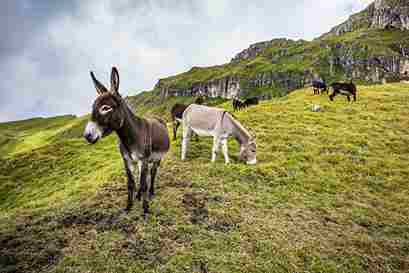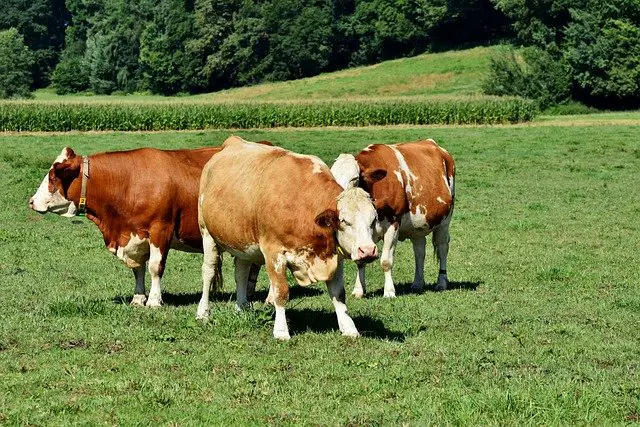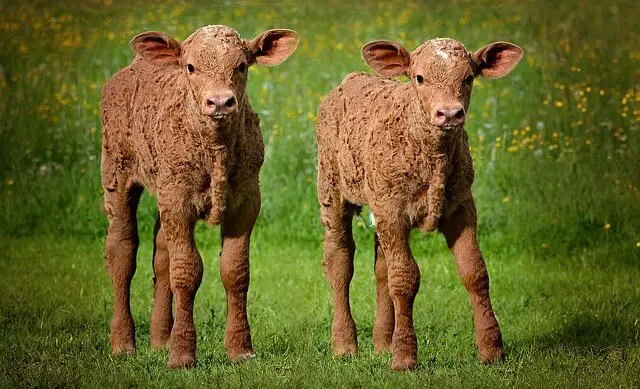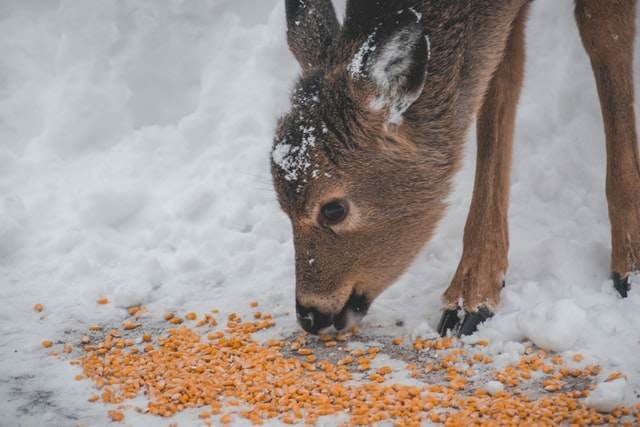Why Are Bulls So Aggressive? (7 Root Causes)
Bulls are known to possess massive feat of strength, which is often bottled out in an intense display of aggression. This is easily seen in how they attack bystanders and handlers, often inflicting serious injuries or even causing death.
Have you ever wondered why they get so angry? Why are bulls so aggressive?
There are three underlying causes of aggression in bulls. First, separation from other cows or bulls in a herd – a bull becomes particularly aggressive when it’s kept (reared) isolated from other cows. Second, due to their social structure – some bulls naturally develop aggressive tendencies when they try to obtain mates and defend their herds. Thirdly, aggression can be passed down as a genetic trait from a bull to its offspring.
Contrary to popular belief, bulls do not get pissed when they see RED. In fact, they are “color-blind,” which means that they are not bothered by red or any other color. They only react when they are charged at either by a person or a moving object.
Today, we will look at the possible reasons for the aggressive tendencies in bulls and what you can do to prevent or evade an attack.

Are Bulls Aggressive By Nature?
Yes, bulls have a natural trait of being aggressive. However, this might be more noticeable in some bulls than others, depending on the breed as well as other internal and external factors.
This rugged show of aggression can be linked to a higher concentration of a male hormone, called testosterone, and the presence of chemicals such as neuropeptides in the brain.
Specifically, secondary male traits like belligerent behaviors and enlarged muscles are often linked to testosterone, while neuropeptides help to increase pain tolerance and aggression.
So, yes, bulls are naturally aggressive.
Why Are Bulls Aggressive (Top 5 Reasons)
Here are the more common reasons why bulls are aggressive:
Social Structure
As earlier indicated, bulls have a social structure that encourages aggressiveness. They are often in charge of a herd consisting of other cows they breed with.
Having two bulls in one herd will often lead to a confrontation, where both fights to establish their authority as the stud animal. This brawl doesn’t last for long and usually involves pushing and head-butting. The stronger bull is the most aggressive and has his genes transferred to the next generation. He is also responsible for protecting the cows in the herd from enemies.
Thus competing for mates and protecting them from intruders makes a bull quite aggressive.
If you have a cattle farm, then it’s advisable not to have more than one male per bovine herd to avoid such confrontations.
Enemy Evasion
The bucking behavior of bulls can also be associated with how they evade predators. Most predators usually go after the flank at first when they attack a bull.
Unfortunately, this is the part of the animal that encloses vital muscles needed for running. In other words, any damage to the flank can immobilize the bull, thus making it an easy prey for predators.
So to protect this vital area, the bull will normally buck (very aggressively) to dislodge an attacker from its flank.
Bull riders understand this, which is why they place a strap around the bull’s flank to get it a bit exasperated so it will buck!
Isolation from the Herd
As earlier indicated, a bull is a herd animal. So, from a natural standpoint, it is supposed to be social. However, some bulls are often raised in isolation before being introduced to a herd. Such bulls often turn out to be more aggressive.
This is the reason why dairy bulls are notorious for being very aggressive. It is widely believed that the method of raising them plays a huge role in their dominant display of aggressiveness. These bulls are not raised by their mothers; instead, they are hand-fed (on a bottle) and isolated from a herd, so they don’t get to socialize much.
Consequently, they turn out to be very dangerous as they get older. They can attack you without provocation!
On the other hand, beef bulls are brought up and nurtured by their dams in a cow herd. As a result, they are usually more social and less aggressive.
Maltreatment by Humans
Raising a bull in isolation alone doesn’t always make it more aggressive. Sometimes, harsh treatment from people can be responsible.
Just like a bull that is raised in a herd, a bull kept in isolation can also turn out to be less aggressive if it’s properly cared for and not “bothered” and harassed by humans. For instance, a bull that is beaten often, taunted, or stoned with rocks will likely become aggressive. So, your actions and that of those around you do matter!
NOTE: Not bothering a bull doesn’t mean you should neglect it. Doing so will only make him more aggressive. The idea is to care for it calmly while leaving him alone.
Brain Chemicals & Testosterone Levels
The aggressive behavior of bulls can also be traced to their brain chemistry and the presence of certain hormones in their body.
To be more specific, a bull’s strength is usually linked to a hormone known as testosterone. By strength, we are referring to secondary male traits like bone mass, muscle mass, and of course, aggressive tendencies. Higher levels of testosterone in the body lead to more masculinity and thus heighten the appearance of these male traits.
Besides testosterone, there are also chemicals in the brain known as neuropeptides, which increase pain tolerance and aggressiveness in the bull.
To sum it up, we can say that bulls are naturally disposed to being aggressive due to the chemical makeup of their brain and body. These chemicals tend to be more prevalent in some breeds than others; that is why bulls like Jerseys are overly aggressive, stubborn, and unpredictable.
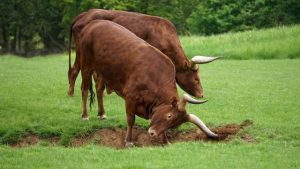
Heredity
While it’s safe to say that all bulls are aggressive, certain breeds are bred to be more aggressive than others. A good example is the Spanish fighting bull used in bullfighting events, which is intentionally raised to be brave and ferocious.
Although these are beef bulls, they are selectively bred for aggressive tendencies.
It is believed that a more aggressive display by the bull makes the bullfight more entertaining. So, the bulls usually turn out as brawlers and will show their lethal horns when humans push them.
Insufficient Feed
There’s a saying that a hungry man is an angry man. This also applies to bulls. Not giving the bulls enough to eat can make them aggressive.
This is common with all cattle, including cows. To counter this, make sure there’s sufficient feed to go round. In the same vein, having a lot of cattle in a single space will increase competition for food and water, which can result in fights. So, try to reduce the cattle density on your farm by providing more space and feed.
Can a bull kill you?
Yes, a bull can kill you, and very easily too.
An adult bull can weigh up to 2200 pounds, and much of this weight is “muscle and bone.” The neck alone can weigh about 320 pounds, which is comparable to the weight of most obese humans. Not to mention the fact that every part of the animal can be used as a weapon – head for battering, horn for puncturing, and foot for crushing.
With a little agitation, a bull can puncture you with its horn or toss you against a fence. And if he was to run you over, the weight on one foot would be enough to shatter your skull.
So, you don’t stand any chance against a ferocious bull.
Even if you were to survive an attack, chances are that you will not remain the same.
What to Do if A Bull Charges at You
So, what do you do when a bull charges at you?
Run away? I wouldn’t do that except you want to invite more trouble.
If you ever find yourself in such a situation, the best thing to do is to back away from the flight zone.
Don’t turn and run, or you risk getting chased and mauled by the bull.
And as you retreat, don’t move hastily. Keep your eyes fixed on the bull until you reach the nearest fence or any other safe exit.
If you own a cattle farm, then you need to know more than how to escape from a bull charge. Here are more tips to ensure your safety and those around you.
- Always be on alert when entering the bull confinement or pasture. Take notice of where the bulls are located and how they behave. It is better to run the farm with someone instead of working alone.
- Bulls often take certain postures when they are “angry” or want to attack someone. Learn to recognize these postures so you can avert some attacks before they happen. Also, maintain a safe distance from them at all times.
- All the structures and facilities in the pasture or holding area should be strong and always in good working conditions. These include fences, walls, gates, chutes, and so on.
- As a handler, it’s best to avoid contact with the bulls and create separation using barriers like walls and chutes.
- Create an exit plan for escape in case of an attack. On no account should you get into a bull pasture without having any escape passage in place
- No matter how gentle a bull appears, never trust it. Always be on guard, even if the bull is tamed.
How to Make Bulls Less Aggressive
As earlier indicated, bulls are naturally prone to aggression, but humans can make it worse. As long as you treat them properly and don’t harass or do anything to agitate them, everything should work out fine.
If you want a bull to be less aggressive, there are certain things you should and shouldn’t do:
- If possible, keep the bull with cows, ideally, in a herd
- However, if you plan to isolate it, give it ample time alone but without neglecting it.
- Give him proper care.
- Don’t harass it or intentionally do things to irritate it (like throwing sticks at it)
- You can appease a raging bull by stroking under the chin, but sometimes it might just be better to get away.
Some bulls can be somewhat docile when around their handlers and people and may never display any aggressive behavior. However, the absence of aggression doesn’t necessarily mean that a bull is safe.
Considering how destructive they can be to other bulls and animals (including humans), you should always be on guard when around them and keep a safe distance.
Why Do Bulls Hate Red? (Bullfights)
Bulls do not hate red. In fact, they cannot see red.
Humans are trichromats, which means they can see the three primary colors – blue, red, and green. Bulls, on the other hand, have dichromatic color vision and cannot see red.
So, if this is the case, then why do bulls attack the color red in a bullfight?
Bulls do not actually attack red. Rather, it’s the movement made with the muleta that gets them angry.
In other words, even if the muleta was a different color, it would still irritate the bull as long as it’s moved the same way.
Matadors choose to use red muletas to mask the blood of the bull.
Conclusion: Why are bulls so aggressive?
While bulls naturally display aggressive behaviors, the way they are handled and cared for has a huge impact on how aggressive they turn out to be. Don’t ever tease a bull or play with it as you would do with a calf. Don’t mishandle it or rub his forehead/horn in a forceful way.
It’s recommended not to have more than one bull in a herd, as bullfights can be lethal, especially when they have horns. Also, for a bull that is out of control, it might be better to cull it.
In addition, when selecting a bull for a herd, don’t just base your decision on its fertility and size; also consider the temperament.

